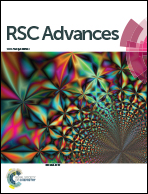794 nm excited core–shell upconversion nanoparticles for optical temperature sensing†
Abstract
Hexagonal core–shell NaYF4 upconversion nanoparticles (UNCPs) based on Nd3+ sensitization for optical temperature sensing were successfully synthesized by a solvothermal method using oleic acid and octadecene as coordinating solvents. Compared to the conventional Yb3+ sensitized UNCPs, the usage of Nd3+ as the sensitizers can shift the excitation wavelength from 975 nm to 794 nm where the optical absorption of water decreased dramatically, and thus make UNCPs more suitable for biological application. The upconversion (UC) luminescence intensity of the 794 nm-excitation UNCPs is comparable to that of the conventional 975 nm excitation, showing that Nd3+ sensitized UNCPs are efficient. The efficiently successive Nd3+ → Yb3+ → Er3+ energy transfer processes in this UNCP were demonstrated by excitation spectra and time-resolved spectra. The temperature dependence of the fluorescence intensity ratios (FIR) for the two green emissions (525 nm and 545 nm) from the thermally coupled levels of Er3+ was studied in the temperature range from 25 to 60 °C under 808 nm excitation, and the temperature mapping of a device was acquired according to this technique. These indicate that Nd3+ sensitized core–shell UNCPs are promising candidates for application in optical temperature sensors.


 Please wait while we load your content...
Please wait while we load your content...